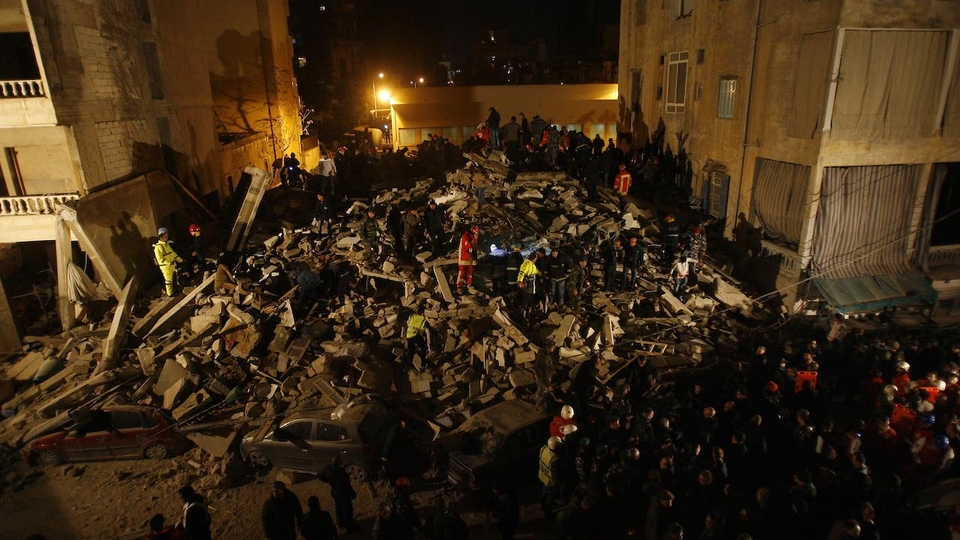Three Years After the Beirut Explosion: Where Does Lebanon’s Disaster Management Stand?
“In the ambulance, I was giving her oxygen. My mom was holding her hands. These are the last scenes I remember.”
Mariana Fodoulian recalls the painful moments on August 4, 2020, when her younger sister Gaia — whom she considered her twin — died of internal bleeding shortly after the Beirut Port explosion.
Moments earlier, Mariana had to use her veterinary medicine training to pierce Gaia’s skin with a needle and place an intravenous tube (IV) for her treatment.
“It was chaos, I don't know if they were nurses or doctors helping us. The whole staff was injured,” Mariana tells The Public Source.
The nearest hospital was in ruins, and three or four others were too crowded to treat Gaia. By the time the ambulance was able to transport them to a hospital in Jal el-Dib, it was too late.
“We are demanding the least of our rights, the right to safety.” —Mariana Fodoulian, sister of port explosion victim Gaia
Three years later, along with the families of the Beirut Port explosion victims, Mariana is still demanding justice and accountability. Her sister is not coming back to life, and she herself can never return to how things were, she says, but she is determined to fight for a better country where she can feel stable and safe.
“We are demanding the least of our rights, the right to safety.”
Because of the havoc that she has seen in hospitals after the blast, Mariana believes Lebanon is unable to face any more disasters.
Lebanon is vulnerable to several “natural” disasters, such as earthquakes, forest fires, floods, landslides, and droughts. It is also prone to other man-made catastrophes like explosions.
It is regarded as one of the leading countries in the Arab region in the design and enforcement of disaster risk reduction policies, with institutions and mechanisms in place to prevent, prepare, respond, and recover. In practice, however, weak coordination, unsustainable funding sources, poor infrastructure, and under-resourced public services not only hinder timely and proper response, but often exacerbate the damages and casualties from disasters.
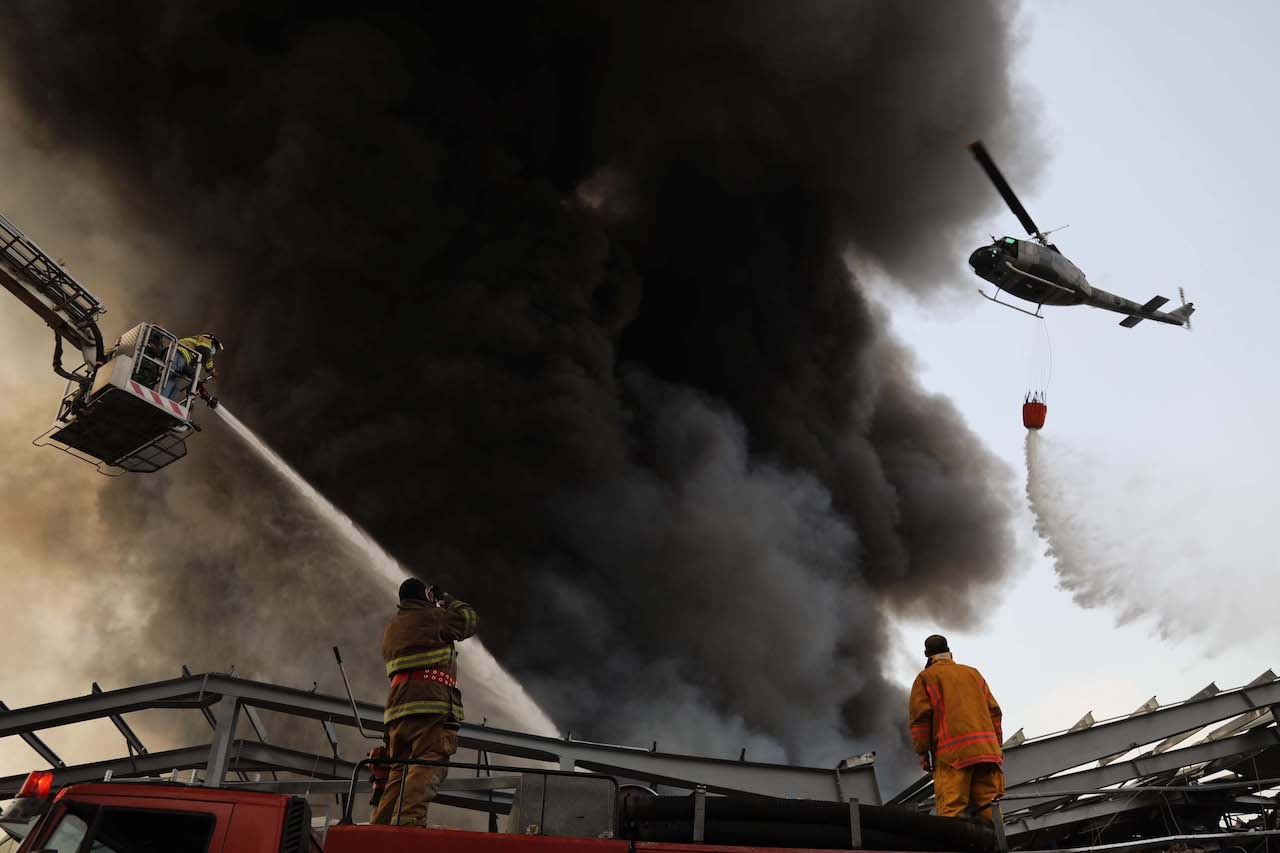
A Lebanese army helicopter, a firefighter on a mechanical ladder, and two firefighters on the ground work on extinguishing the fire that broke out at the port, one month after the August 4 explosion. Beirut, Lebanon. September 10, 2020. (Marwan Tahtah/The Public Source)
The 2020 explosion is not a disaster that could have been prepared for — nor is it an isolated case of criminal negligence. In 2021, a Humans Rights Watch report found that many senior political figures and officials, notably in the Ministry of Public Works and Transportation, Ministry of Finance, and General Directorate of State Security, were informed of the risks of storing ammonium nitrate in Hangar 12 and failed to devise an adequate “emergency response plan or precautionary measures should a fire break out at the port.”
Every summer, despite being aware of the looming threat of forest fires, the Lebanese government does little to mitigate the risks and is barely capable of responding.
“In terms of natural disasters in Lebanon, honestly, let’s say may God help us if anything happens." —Lieutenant Ali Najem, Beirut Fire Brigade
“We have a crisis in terms of equipment for search, rescue, and first aid,” the head of the press office at the Beirut fire brigade, Lieutenant Ali Najem, tells The Public Source.
“In terms of natural disasters in Lebanon, honestly, let’s say may God help us if anything happens,” he says.
Lebanon’s Disaster Strategy: Theoretically Leading, Practically Fragmented
Over the past two decades, Lebanon ratified two international frameworks for disaster management put forward by the United Nations Office for Disaster Risk Reduction (UNDRR): the Hyogo protocol in 2005, and its successor the Sendai framework in 2015.
The stated goals of these frameworks is to reduce the risk of disasters and the loss of lives and livelihoods. The government is responsible for planning and implementation, in coordination with local governance and the private sector, while the UNDRR is tasked with support, follow-up, and review.
In 2010, five years after ratifying the Hyogo protocol, Lebanon established the Disaster Risk Management Unit (DRMU) under the Presidency of the Council of Ministers, in coordination with the UNDP.
The DRMU is the official national body concerned with all stages of disaster risk reduction, including prevention, preparedness, response, and disaster recovery. It is responsible for preparing national strategies, in line with the Sendai framework, and works closely with other governmental agencies, such as the National Center for Scientific Research (CNRS), the Lebanese Army, the Civil Defense, Fire Brigade, as well as different ministries.
The DRMU has not received sustained and systematic funding from the Lebanese government–even before the economic crisis began in 2019. The majority of its activities are funded through external grants — including some $5 million from the Swiss Agency of Development and Corporation (SDC). This funding system is both unsustainable and unlikely to change in the near future, according to a 2019 report by global think tank ODI. Even The World Bank noted, in 2014, that “policies and plans are not supported by adequate budgets, and implementation is often dependent on donor support.”
The Disaster Management Unit does not receive sustained and systematic funding from the Lebanese Government. It depends on external grants and donor support.
In addition to the lack of financial support, multiple studies from the last decade reveal gaps in Lebanon’s disaster management projects. In 2012, a study on Lebanon risk reduction efforts by the UNDRR (then UNISDR) pointed out “delays in clarifying national institutional mandates, coordination structures and resource allocation.”
The study also stated that the enforcement of building codes and standards was difficult because of the weakness of the public sector. Lebanon’s disaster risk management projects have also been criticized for ignoring socio-cultural factors, excluding local communities from the decision-making process, and lacking a clear command structure, communication, and coordination between the parties involved in disaster response.
Despite the existing data on mortality and people affected, economic loss, and infrastructural damage in the aftermath of disasters, Lebanon's progress in disaster management has not been reported systematically.
“Lebanon’s political system has to be navigated at all scales in great detail in order to achieve even the seemingly simple groundwork for preparedness and response coordination mechanisms,” according to the ODI study.
Even though a national strategy for disaster risk reduction was devised and finalized in 2018, it has, by all appearances, yet to be approved by the council of ministers. The Public Source was not able to obtain a copy of the strategy from the UNDRR by the time of publication.
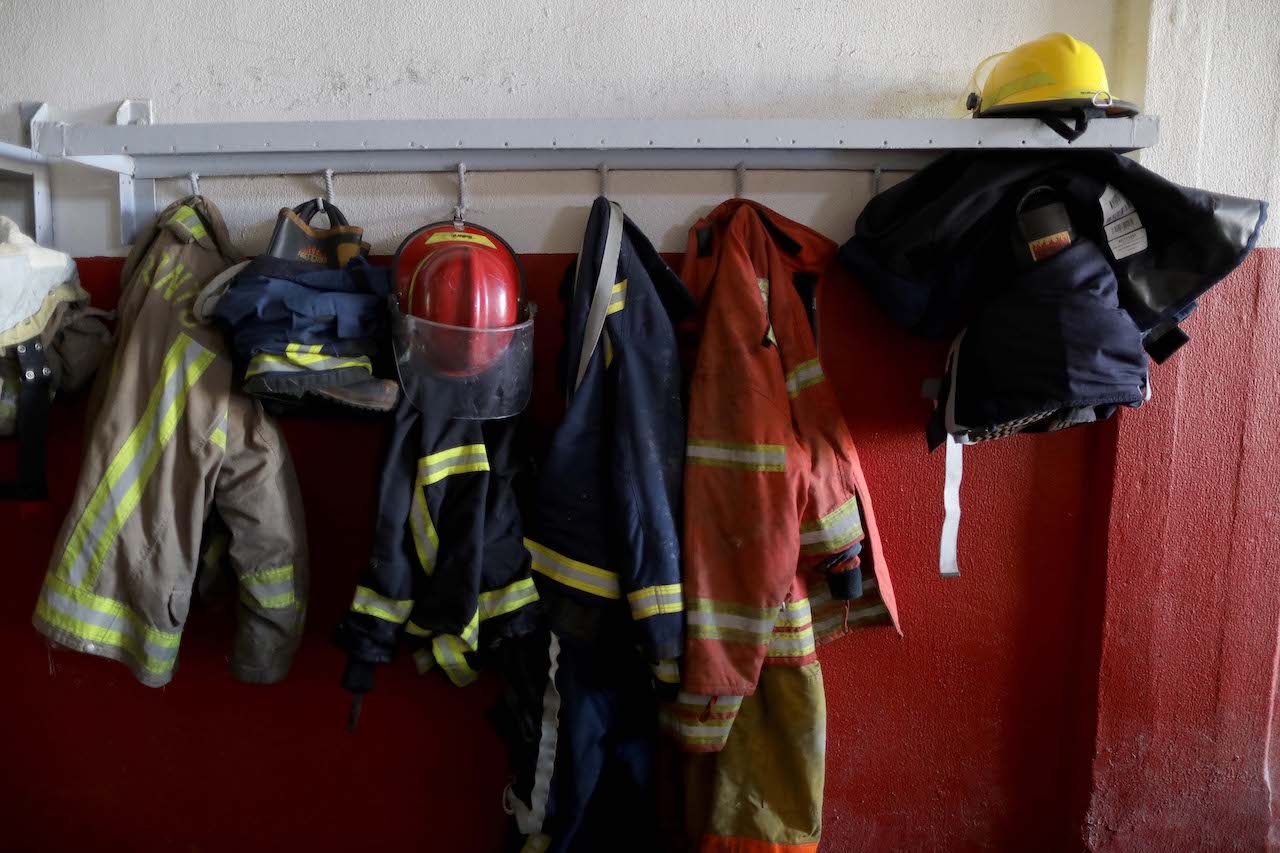
Firefighting suits and helmets hanging on a wall at the Beirut Fire Brigade. Lieutenant Ali Najem says the brigade does not have the protective fire proximity suits for its members who risk their lives on the job. Karantina, Lebanon. June 6, 2023. (Marwan Tahtah/The Public Source)
In addition, Lebanon’s legal frameworks exclude refugees — hundreds of thousands of whom live in Lebanon in precarious conditions that leave them more vulnerable in the event of a disaster — from formal risk governance mechanisms.
When Storm Norma struck Lebanon in January 2019, refugee camps in Akkar and the Bekaa Valley were the hardest hit, yet the Syrian communities who were impacted were not in the purview of the national strategy, and many were left behind, without UNHRC assistance.
Lack of coordination and means in public health emergencies was again evident in 2020 beyond the port explosion. Loosely defined responsibilities became a problem when Lebanon’s government had more than 10 competing and overlapping committees that failed to put forward a clear strategy to contain COVID-19.
Fragmentation can also translate to the most simple response mechanisms we take for granted. One example has been nagging at Ali Najem of the Beirut Fire Brigade.
In Lebanon, people must memorize different numbers for the Red Cross, security forces, the fire department, and Civil Defense. Najem says he’s been suggesting the implementation of a single emergency number, as is the approach in many other countries, at strategic meetings, but this idea has yet to be taken into consideration.
The DRMU did not respond to multiple requests for interviews by The Public Source, nor to an access to information request filed in June.
Pre-Disaster Preparedness: Understanding the Risks
Disaster risk management in Lebanon is all the more crucial given the many risks to which the country is prone.
The National Center for Scientific Research (CNRS) is the scientific arm of Lebanon’s government. It is responsible for conducting research on potential risks and mapping the probability and intensity of floods, fires, and landslides. The CNRS also devises an early warning system and works on disseminating information about disasters in real time.
The impact of global warming and regional fault lines leave Lebanon particularly vulnerable to natural catastrophes, which can be compounded by bad infrastructure.
During a November 2022 conference, the CNRS unveiled dashboards that track floods, fires, storms, and landslides, based on on-the-ground research as well as analysis of satellite data.
Aside from advising the DRMU on disaster risk, the CNRS assesses responses and gives recommendations, but they do not have the jurisdiction to implement action on the ground, CNRS director Chadi Abdallah told The Public Source in November.
Abdallah explains that they regularly meet with a DRM committee that includes representatives from different relevant agencies. "It is tedious work."
“As people, we are experienced, because we have faced a lot, but our resources are limited. This is the gap.” —Chadi Abdallah, National Center for Scientific Research director
His experience in conferences abroad has convinced him that Lebanon’s disaster adaptation plan is advanced. However, the work has been harder since the onset of the economic crisis and political limbo due to the lack of resources, he admits.
“As people, we are experienced, because we have faced a lot,” he says. “But our resources are limited. This is the gap.”
Volunteers on the Ground: Experienced, but Unequipped
Once disaster strikes, the Civil Defense and the fire brigade are the main actors on the ground. Their responsibilities include firefighting, search, relief, and rescue, as well as preventing and reducing the loss of life and property in the event of war and natural disasters.
There are plans in case of an earthquake, explosion, flooding, or other disasters, and the DRM Unit holds frequent meetings to discuss priorities, Lieutenant Ali Najem tells The Public Source.
“But here in Lebanon, no matter how much this unit meets and works and plans, can we implement those plans in the current situation?” he asks rhetorically.
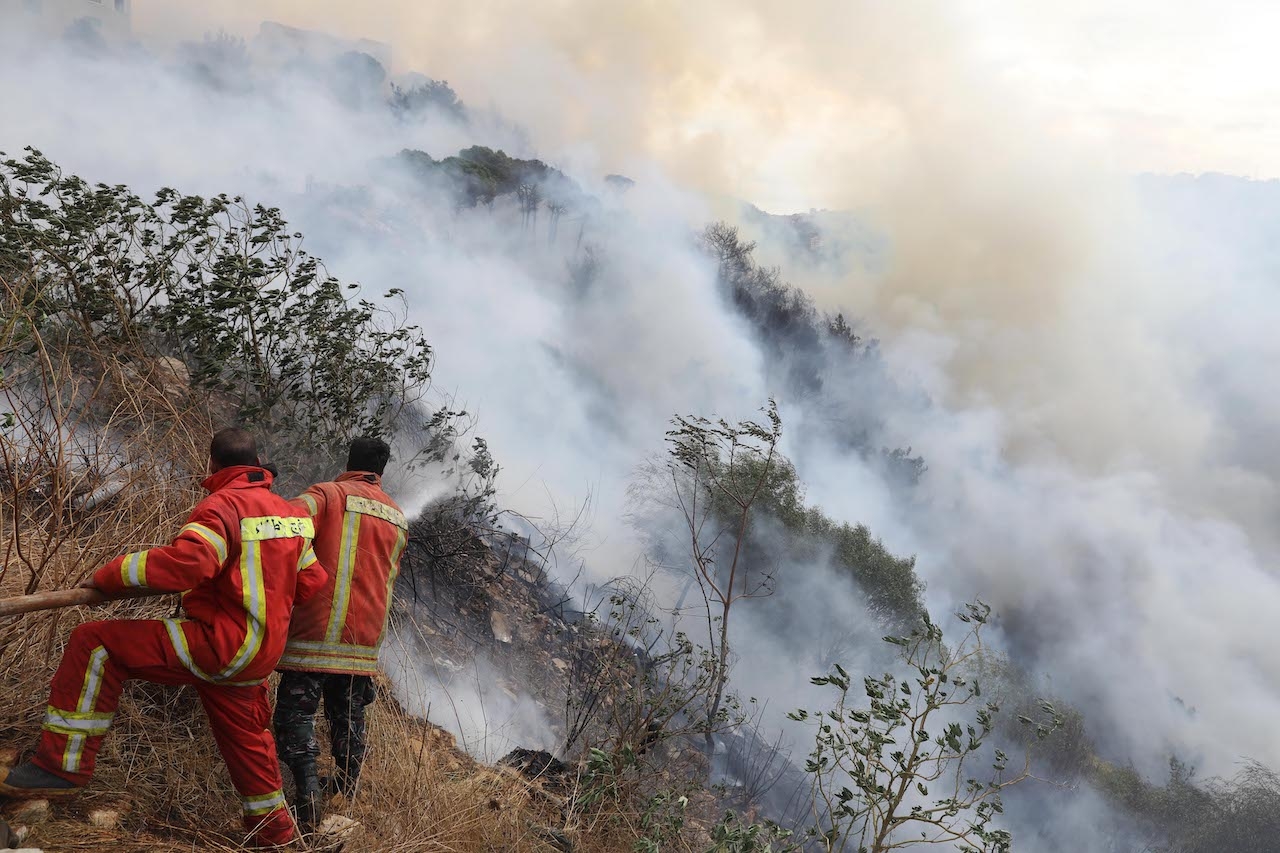
Firefighters try to extinguish a forest fire in Bchamoun. One member of the brigade was severely burned due to a lack of proper protective gear. Bchamoun, Lebanon. November 30, 2021. (Marwan Tahtah/The Public Source)
The fire brigade and the Civil Defense share common concerns and challenges. With the soaring exchange rate, all their necessities are priced in dollars, yet the meager funding they receive remains in Lebanese Lira. As a result, they face a shortage of basic equipment: firefighting suits, tires, hoses. Their vehicles are worn down, often ending up parked away because of the prohibitive costs of repairs if anything breaks down. A photograph from 2021 showing medics pushing an ambulance that had run out of gas became a striking example of the very real impact of the fuel crisis on the capacity for emergency response.
These difficulties, coupled with poor infrastructure, translate into worrisome realities. For example, Lebanon has no planes for firefighting, and army helicopters are not enough to fill that gap, Najem says. The lack of proper equipment leaves firefighters helpless in the event of a fire that is not reachable from the ground, especially given that firefighting trucks do not have access to continuous water supplies through hydrants.
The fire brigade and the Civil Defense lack firefighting suits, tires, hoses. Their vehicles are worn down, often parked away, because of prohibitive repair costs, when anything breaks down.
Najem recalls when an explosion and a fire broke out in a residential building in October 2020 in the Beirut neighborhood of Tariq el-Jdideh. The Beirut Fire Brigade had to delay rescue operations because its mechanical ladders, intended for the evacuation of residents on higher floors, could not pass through the area’s tight alleyways. The firefighters had to wait for a moving company to provide smaller ladders so they could rescue people. Four people died immediately due to the explosion. Many suffered from excessive smoke inhalation , which, Najem says, could have been avoided had the firefighters had the right equipment from the get-go.
“Now imagine an earthquake,” he says.
“In my personal opinion, we cannot be like the countries that are prepared for earthquakes and natural disasters. Our equipment… 3ala add el hal… it’s barely enough. What can I say,” he trails off.
Even though equipment is essential, another concern troubles Najem more. Members of the fire brigade are underpaid and uninsured. While salaries were enough to ensure a decent living before the economic crisis, he now sees members of the brigade struggle to make ends meet, coming to work tired and unable to give their all to the demanding tasks required of them.
"The salary isn’t worth the price of a life," he animatedly emphasizes.
The Civil Defense raises similar concerns, adding that its personnel often face difficulty to even reach their workplaces because of the cost of transportation.
If anything were to happen in a mission, the volunteers — who already operate without sufficient equipment — cannot afford healthcare and treatment.
Members of the fire brigade are underpaid and uninsured.
“The human element in Lebanon is very strong and mighty, and they throw themselves into danger. But this human element needs funding and equipment,” Najem says.
This sentiment is shared by every expert who spoke to The Public Source. All say that Lebanon has the experience and manpower to face disasters, but not the resources to do so properly.
Medical Mayhem
As insufficient means for disaster preparedness heighten the risk of human casualty, Lebanon’s healthcare system also finds itself struggling in times of catastrophe.
Anis Germany moved between half a dozen private and governmental hospitals throughout his training at the Lebanese University medical school. Only one hospital shared its disaster protocol, the “yellow code” outlined in the hospital’s external accreditation, with the medical student during his internship.
“It’s surprising for Lebanon. Many explosions had happened in the past, but it was the first time I heard about [a protocol],” the young doctor says. “It should be systematic across hospitals in Lebanon.”
However, none of this theory was put in practice when the blast ripped through the city on August 4, 2020. Then an intern, Germany was off-duty at the time of the explosion, but rushed to the hospital when he got news of the blast.
“It was complete mayhem, honestly. There were people shouting, people bleeding.”
He made his way through a panicked crowd and got to the emergency room, looking for a superior to ask for directions.
“I asked her: ‘Who’s leading? Who is in charge at the ER?’ She said ‘forget it, just find somebody and take care of them.’”
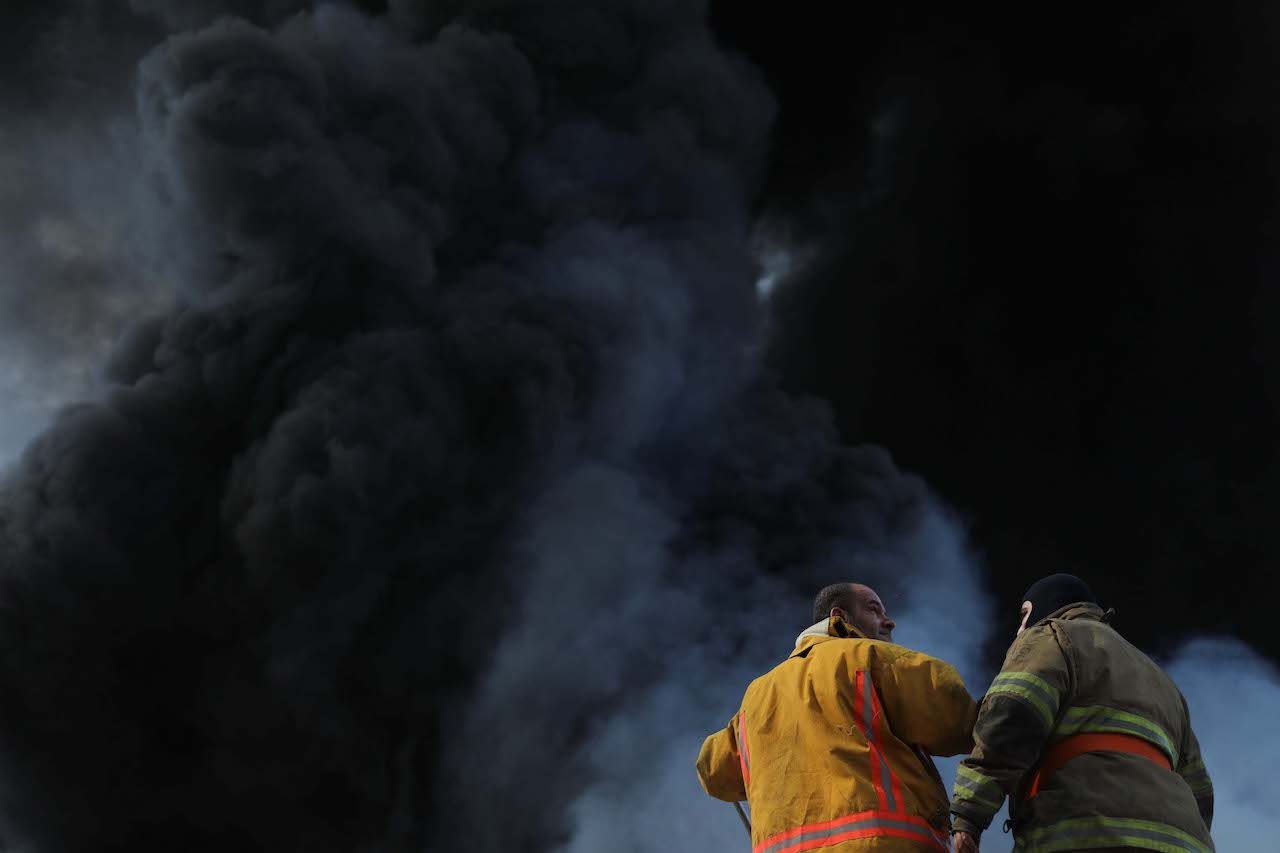
Firefighters face black smoke from a fire that broke out near the silos, one month after the Beirut port explosion. Beirut, Lebanon. September 10, 2020. (Marwan Tahtah/The Public Source)
A study on 24 hospitals in Beirut, published in December 2020, found that they all have a disaster and emergency response plan, and most are equipped with basic medical and pharmaceutical supplies, onsite laboratories, and blood banks. But only two-thirds have a backup communication system and 79 percent of them performed disaster drills.
“Over the years, we have activated [disaster response plans] and after every activation, we do debriefs and updates and plan to make sure that we address gaps,” says Dr. Eveline Hitti, the chairperson of the emergency department at the American University Hospital (AUH). “We are one of the most ready institutions because we have done this so many times.”
However, there is no structured coordination among hospitals, or with the Ministry of Public Health, the Civil Defense, and the fire brigade, Hitti says. The hospital is not involved in nationwide strategy planning. A study published earlier this year found that communication, coordination, human resources, and supplies were critical challenges that hindered the emergency responses of hospitals on August 4. The study identified “proper triage, emergency centers, and outdoor treatment tents” as necessities to effectively respond to future disasters.
Mariana Fodoulian, sister of Gaia and president of the Beirut Port Explosion Victims’ Families Association, experienced first hand what these challenges can look like on the ground, the day of a disaster.
“They should’ve told us something might happen [at the port] and that we needed to evacuate. They didn’t." —Mariana Fodoulian, Beirut Port Explosion Victims’ Families Association president
While she doesn’t blame hospitals and medical workers for the chaos that ensued in the aftermath of the explosion, she wants to hold the Lebanese state accountable for not preparing for and activating an emergency plan despite knowing the danger that lay in the port.
For her, accountability for the blast starts from the day the ammonium nitrate entered the country, and extends to the lack of proper response when disaster hit. Authorities, she says, should have warned nearby residents as soon as the fire broke out in the port, which could have saved some lives.
“They should’ve told us something might happen [at the port] and that we needed to evacuate. They didn’t."
Throughout the last three years of her sustained fight for justice and accountability, Mariana often hears people say “what happened will not happen again.” But other disasters might happen, and she fears that Lebanon will still not be able to respond.
“If an earthquake happens,” echoing Najem, chaos will reign like it had on August 4, she concludes.
